Overview of the Emotiv Epoc braincomputer interface
Here they have long been distressed that there is no hero in the fatherland who would buy some neurocomputer interface, torment him for the benefit of the community and share the results of torment with others. Actually there is. I bought it and tried to use it. Details with pictures under the cut.
About 5 years ago, when I began my career, at my work in the evenings or on Fridays, they liked to organize “half an hour” - to drive in a counter. So there were historical circumstances that I liked strategies more, so my reaction was not very good. Actually, then I began to think about how to speed it up. In addition to training, I came to the conclusion that you can try to accelerate the reflex arcs or even get around them. I started searching and found several similar interfaces. Actually, this is how I entered the topic a bit.
')
Neurocomputer and braincomputer interfaces should be distinguished (or in more detail here ). Initially, research was conducted as early as the 70s of the 20th century. Both in our country and abroad (Schmidt, Fetz, Baker abroad and NP Bekhtereva in our country). I will continue using the abbreviation BCI (Brain-Computer Interface). It is also necessary to distinguish these interfaces according to the principle of connecting to a person:
According to the above classification, Emotiv Epoc is a wet non-submersible BCI with passive electrodes.
Ordered through PayPal. For 3 days I made myself a card from Alfabank. Put denyuzhshku. After another 7 days he was at my house, having flown almost half the world . Thanks to UPS for our happy childhood.
Came a cute black suitcase.
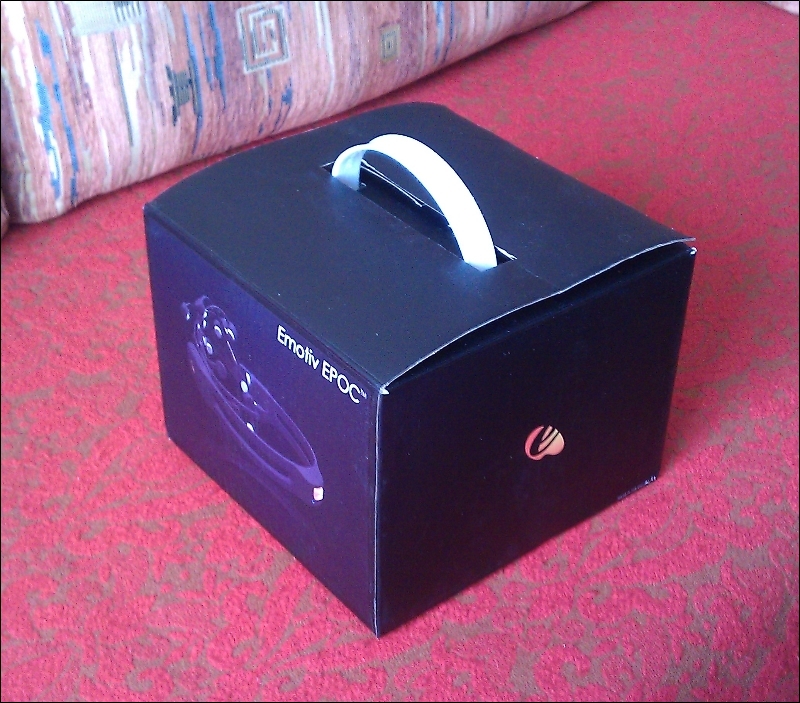
Inside it turned out
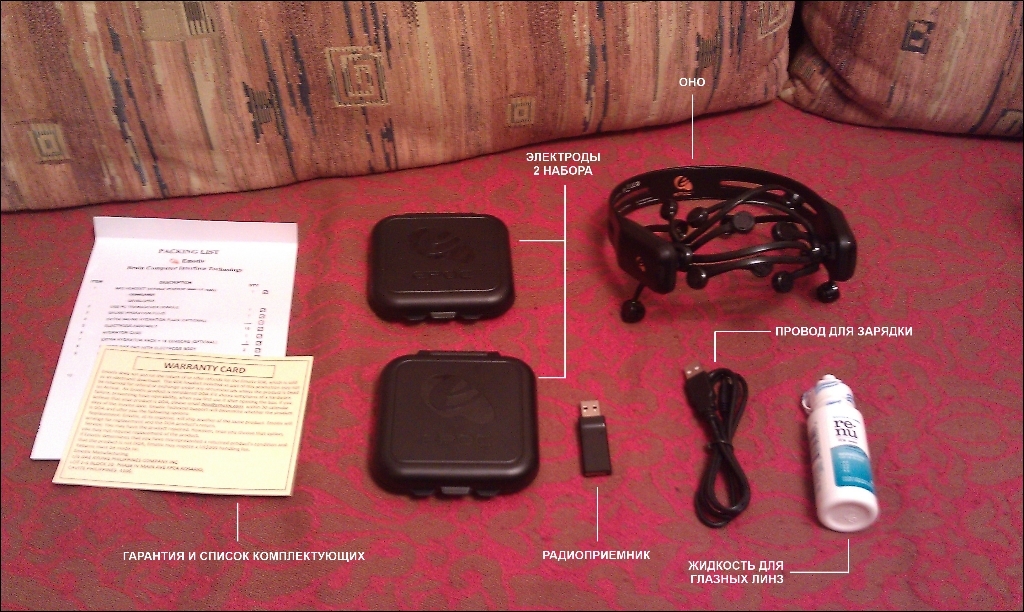
Go through the list
Processor: 2.4 GHz Intel Pentium 4.
RAM: 1 GB
Hard Drive: 50 MB
Optional: 1 or 2 USB connectors, depending on the number of devices used
Operating system: Windows XP SP2, Windows Vista, Windows 7
Number of sensors: 14 pcs
Sensor type: passive, wet
Gyroscopes: 2 pcs
Battery: 7-12 hours without recharging
Computer connection : wireless radio connection
In the developer's kit: SDK for development in C ++, C #
Researcher's Recruitment: Researcher's SDK, which includes a special graphical package for analyzing and processing data
Inside each box is 16 interchangeable electrodes that are inserted into the device itself.
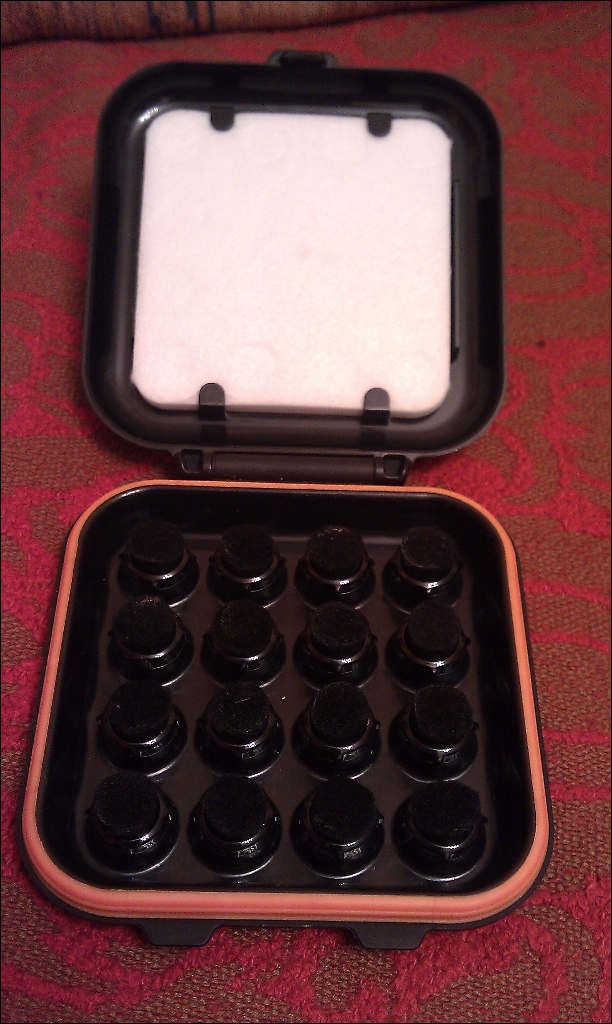
Terribly inconvenient to pick them out. But, as they did, they did it. The electrode itself is quite small.

It consists of two parts. Actually electrode and tab. The electrode has a gold plating, so that it does not oxidize from moisture and for better contact.
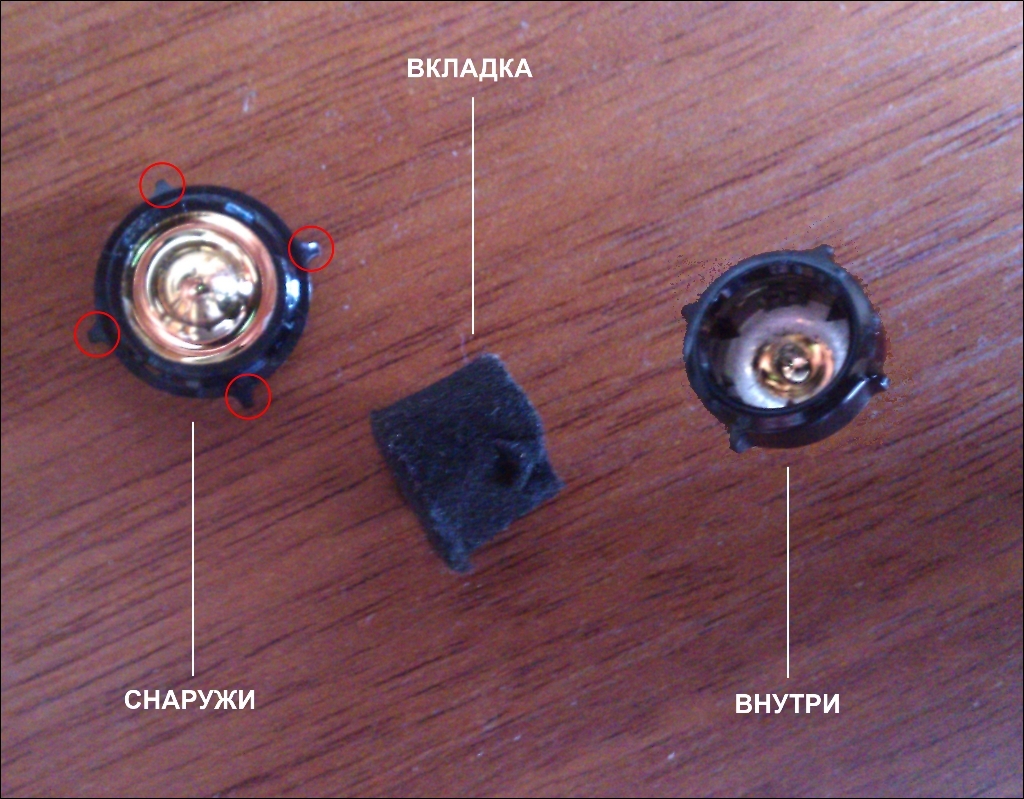
Red circles in the photo highlighted the protrusions, which I stripped off my fingers when I twisted the electrodes out of the package and screwed them into the device. I am thinking about making some plastic key to simplify my life. The tab structure resembles the material from which the core and pen are made in felt-tip pens. It holds the liquid well, but at the same time it does not flow in a stream.
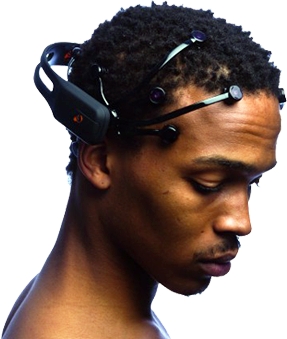
In size it resembles headphones. Only the bow they do not top, and behind. There is also a switch. Connectors for sensors on the device itself 18 pieces. There are 16 sensors, and the manual says that the number of channels is 14. This is explained simply. The real channels through which the signal goes are really 14. Another two channels are reference. When BCI works, it catches electrical signals not only from the brain, but also from the muscles - the so-called myogram . These signals are stronger than from the brain and need to be filtered. For this, an additional signal is read from where there are signals from the muscles, but there are no signals from the brain - these are often points in the temporal region or ear area. Since on each side there are 2 options for the location of the reference channels (temple and behind the ear), we get 4 additional connectors for sensors.


If you follow the instructions literally, then my preparation for operation looked like this:
After these procedures, it said that there is a contact. The long procedure of soaking is due to the fact that the material of the tabs absorbs well a lot of liquid. But at the same time when putting on the humidity is almost not felt. Maybe quite a bit in the first 10 seconds after dressing. The head after all the procedures was completely dry. In general, I am rather hairy, so I was worried that I would have to shave my hair for more reliable contact. Thank God, did not have to. So bald and shaved have no advantages when using.
Sets of software for different shipments vary. The headset is included in all kits.
In order to use BCI, they need to learn how to use. For this, developers offer several programs and several approaches.
The first tab Headset Setup is the main. It checks the general presence of the connection, and the main calibration is carried out (maybe, it was slightly wetted somewhere ...). Each user has his own profile, so several people can use one device.
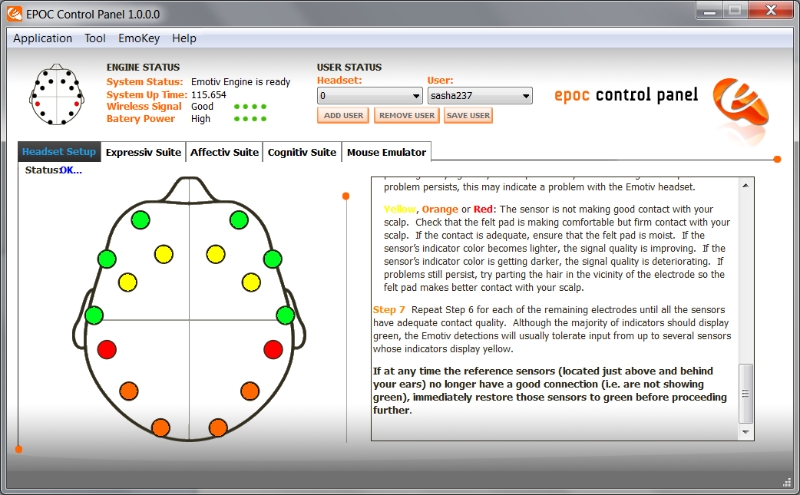
In the control panel, you can immediately observe the bonus - how the system catches certain signals from the muscles. This is the second tab - Expressiv Suite. You can make faces, wink and the system really shows on the screen what you have depicted. You can also attach certain messages, text messages or emoticons to them, that is, your emoticons will be a real reflection of your state.

On the third tab of the Affective Suite, you can track in time the basic state and see the prevailing.

You can experiment on the fourth tab of the Congnitiv Suite. We have a cube and 14 basic actions with it (according to the number of degrees of freedom up-down-right-left-forward-back, 6 types of rotations around the axes in both directions, the same appearance and disappearance). The level of training varies from the simplest - 1 signal - to the most difficult - 4 signals. After a couple of weeks of training, I began to get 2 simultaneous signals from 14 random ones to choose from. Make at least one signal can be learned in just a couple of minutes. You can help yourself with limbs, swing, puff and do other funny things.
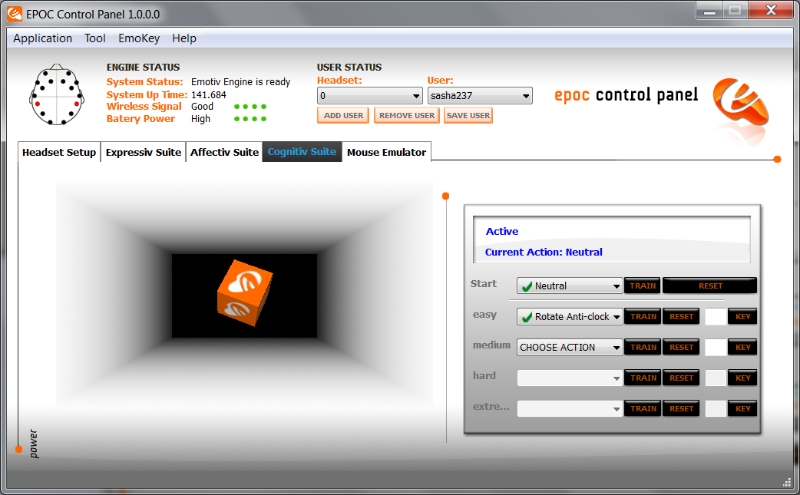
On the last tab of the control panel, you can try to control the mouse.

Auxiliary information panel
On it you can turn on and off individual electrodes.
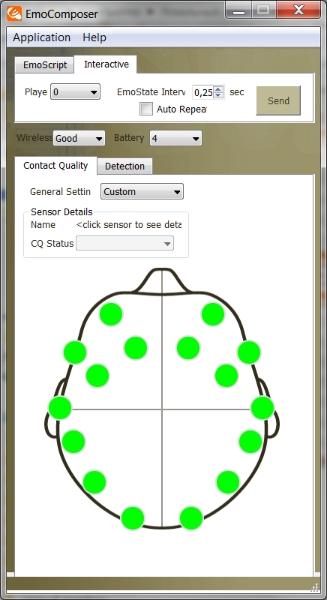
And tie these electrodes to specific actions to train a particular skill. They also show the percentage of successful or not very successful skills, that is, you can monitor your progress.
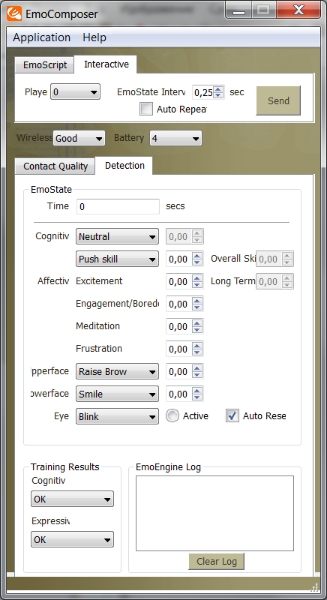
Similarly, you can train your skills with the help of the games in the kit. The first is a set of mini-games on a flash, there are only three of them.
The simplest is the Jedi games. If you remember the Star Wars episode, when Luke had to pull his fighter out of the swamp with force. Actually, this is a game - feel yourself like Luke. We concentrate on only one main movement. Actually, this is a concentration training.

Next - ping pong against the computer. There are already two movements. Up down. Somewhat acidic green.
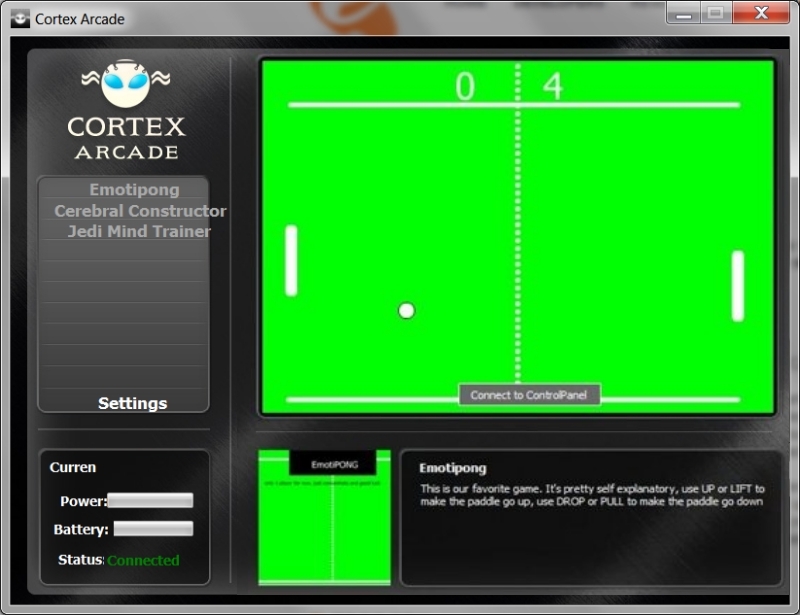
And the last minigame is tetris. Great and powerful. 4 actions (up-down-right-left). Remember everything. Never in your life play tetris with your brains. It delays and turns. The system is like that - you play as usual Tetris, pressing the buttons of the keyboard, and the system learns to recognize in the background. At some point in time, it comes to the conclusion that it has learned and begins to duplicate. At this point, the show begins with gags. It comes out especially funny when you want to move the shape to the side, the signal comes from the BCI, then the signal comes up to the finger, and you send the second signal, as a result it moves to the side 2 times. It is treated by removing the hand from the keyboard and pressing on the empty space.

In addition to the above, there is a 3D toy about the adventures of a novice telepath. Written on the Unity3D engine. There you can use your thoughts to lift rocks and rocks, bend trees, repair bridges. Unfortunately, I did not find any korovans for the robbery, but I think they have somewhere. But there are some vigorous old men who will teach you all the tricks of telepathy. In fact, this is mastering the same skills, but only in the form of a game.
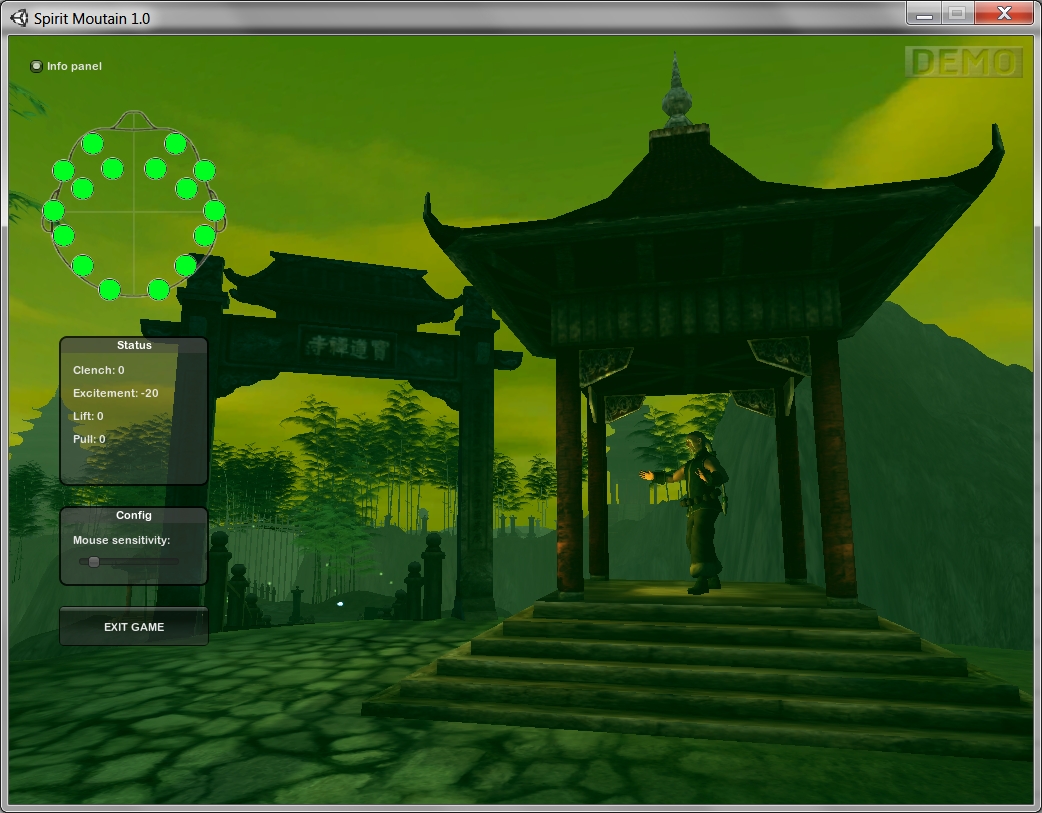
There are some more interesting tools , for example, a map of brain activity, which allows you to look at various brain rhythms and activity areas. Write something, and so on. SDK for programmers, as SDK for programmers, we receive a signal, process it, do something according to the results of processing. There are examples of use, technical documentation, so there are no comments here. The examples are written in C ++ using Qt, OpenGL, DirectX, in C # with various gadgets, in Python. There is a small community of developers . So far, everything has been done under Windows, so that users and programmers of other operating systems should use emulators.
UPD Added by the proposal of the guys video on TED
FAQ
Video application
Instead of intro
About 5 years ago, when I began my career, at my work in the evenings or on Fridays, they liked to organize “half an hour” - to drive in a counter. So there were historical circumstances that I liked strategies more, so my reaction was not very good. Actually, then I began to think about how to speed it up. In addition to training, I came to the conclusion that you can try to accelerate the reflex arcs or even get around them. I started searching and found several similar interfaces. Actually, this is how I entered the topic a bit.
')
Some history and facts.
Neurocomputer and braincomputer interfaces should be distinguished (or in more detail here ). Initially, research was conducted as early as the 70s of the 20th century. Both in our country and abroad (Schmidt, Fetz, Baker abroad and NP Bekhtereva in our country). I will continue using the abbreviation BCI (Brain-Computer Interface). It is also necessary to distinguish these interfaces according to the principle of connecting to a person:
- submersible - proper implantation in the brain or fusion with nerves;
- partially submersible - electrodes are located on the surface of the brain or near the nerves;
- non-submersible - electrodes are located on the skin surface or are even somewhat removed from it.
- wet - you need to moisten with a special liquid for better contact;
- dry - no need to moisten.
- passive - just catch the signal and transmit it further;
- active - they do not transmit a signal back, they simply make its primary processing right at the point of attachment. And the signals are transmitted back by completely different electrodes.
According to the above classification, Emotiv Epoc is a wet non-submersible BCI with passive electrodes.
How ordered and delivered
Ordered through PayPal. For 3 days I made myself a card from Alfabank. Put denyuzhshku. After another 7 days he was at my house, having flown almost half the world . Thanks to UPS for our happy childhood.
Came a cute black suitcase.

Inside it turned out

Go through the list
- With the paper, I think, it is clear that all instructions, programs, etc. can be downloaded from the manufacturer’s website, so there were no disks and flash drives. Only a guarantee and a list of what was sent.
- Electrodes for connection to the device. About them in more detail below. I ordered 2 sets of electrodes, as I have a tendency to break something for the sake of interest.
- The device itself. It is the same size as the headphones, only the bow between the ears is not from above, but from behind. The device is wireless.
- Charging USB cable for the device during operation is not required. According to the manufacturers, the battery lasts for 7 hours. I have never been able to completely discharge the device.
- The radio module is actually the second part of the wireless interface for connecting to a computer. In principle, it could be done on the same Bluetooth. Well, as they did, so they did. Perhaps this reduces interference. Friends asked about the radio emission. At first I did not find it, I wanted to carry it to other friends in the laboratory, so that they would ring it. Then I found the CE and UL certification badges. That is, for Europe and the United States it is suitable. Plus, if the phonil is too strong, then the device would interfere with itself. So I think there should be no problems.
- Eye lens fluid is a sterile liquid for wetting the electrodes. So the circumstances are that dry BCIs work a little worse than wet ones.
Technical requirements
Processor: 2.4 GHz Intel Pentium 4.
RAM: 1 GB
Hard Drive: 50 MB
Optional: 1 or 2 USB connectors, depending on the number of devices used
Operating system: Windows XP SP2, Windows Vista, Windows 7
Specifications
Number of sensors: 14 pcs
Sensor type: passive, wet
Gyroscopes: 2 pcs
Battery: 7-12 hours without recharging
Computer connection : wireless radio connection
Additional specifications
In the developer's kit: SDK for development in C ++, C #
Researcher's Recruitment: Researcher's SDK, which includes a special graphical package for analyzing and processing data
About electrodes
Inside each box is 16 interchangeable electrodes that are inserted into the device itself.

Terribly inconvenient to pick them out. But, as they did, they did it. The electrode itself is quite small.

It consists of two parts. Actually electrode and tab. The electrode has a gold plating, so that it does not oxidize from moisture and for better contact.

Red circles in the photo highlighted the protrusions, which I stripped off my fingers when I twisted the electrodes out of the package and screwed them into the device. I am thinking about making some plastic key to simplify my life. The tab structure resembles the material from which the core and pen are made in felt-tip pens. It holds the liquid well, but at the same time it does not flow in a stream.
About the device itself

In size it resembles headphones. Only the bow they do not top, and behind. There is also a switch. Connectors for sensors on the device itself 18 pieces. There are 16 sensors, and the manual says that the number of channels is 14. This is explained simply. The real channels through which the signal goes are really 14. Another two channels are reference. When BCI works, it catches electrical signals not only from the brain, but also from the muscles - the so-called myogram . These signals are stronger than from the brain and need to be filtered. For this, an additional signal is read from where there are signals from the muscles, but there are no signals from the brain - these are often points in the temporal region or ear area. Since on each side there are 2 options for the location of the reference channels (temple and behind the ear), we get 4 additional connectors for sensors.


About operation
If you follow the instructions literally, then my preparation for operation looked like this:
- Charged the device. I downloaded, installed software / drivers / SDK.
- Wet the sensors.
- Checked that well soaked.
- Screw the sensors into the device and peel off his fingers.
- Checked if they are dry, if you need wetted yet.
- Put on, turned on, checked the connection, if necessary, wet it again.
- I realized that my sensors were dry at all and what I was doing before that was not even soaking.
- Soak the sensors.
After these procedures, it said that there is a contact. The long procedure of soaking is due to the fact that the material of the tabs absorbs well a lot of liquid. But at the same time when putting on the humidity is almost not felt. Maybe quite a bit in the first 10 seconds after dressing. The head after all the procedures was completely dry. In general, I am rather hairy, so I was worried that I would have to shave my hair for more reliable contact. Thank God, did not have to. So bald and shaved have no advantages when using.
About software
Sets of software for different shipments vary. The headset is included in all kits.
- The basic set also includes a disc with toys.
- The developer’s kit includes an SDK, which can be downloaded and installed immediately after payment - I ordered it myself
- The researcher's SDK includes a researcher's SDK and a program for tracking signals on different sensors.
- The rest of the kits differ only in licenses, and those to whom they are given - educational institutions, research laboratories, game development campaigns ...
In order to use BCI, they need to learn how to use. For this, developers offer several programs and several approaches.
Control panel
The first tab Headset Setup is the main. It checks the general presence of the connection, and the main calibration is carried out (maybe, it was slightly wetted somewhere ...). Each user has his own profile, so several people can use one device.

In the control panel, you can immediately observe the bonus - how the system catches certain signals from the muscles. This is the second tab - Expressiv Suite. You can make faces, wink and the system really shows on the screen what you have depicted. You can also attach certain messages, text messages or emoticons to them, that is, your emoticons will be a real reflection of your state.

On the third tab of the Affective Suite, you can track in time the basic state and see the prevailing.

You can experiment on the fourth tab of the Congnitiv Suite. We have a cube and 14 basic actions with it (according to the number of degrees of freedom up-down-right-left-forward-back, 6 types of rotations around the axes in both directions, the same appearance and disappearance). The level of training varies from the simplest - 1 signal - to the most difficult - 4 signals. After a couple of weeks of training, I began to get 2 simultaneous signals from 14 random ones to choose from. Make at least one signal can be learned in just a couple of minutes. You can help yourself with limbs, swing, puff and do other funny things.

On the last tab of the control panel, you can try to control the mouse.

Auxiliary information panel
On it you can turn on and off individual electrodes.

And tie these electrodes to specific actions to train a particular skill. They also show the percentage of successful or not very successful skills, that is, you can monitor your progress.

Similarly, you can train your skills with the help of the games in the kit. The first is a set of mini-games on a flash, there are only three of them.
The simplest is the Jedi games. If you remember the Star Wars episode, when Luke had to pull his fighter out of the swamp with force. Actually, this is a game - feel yourself like Luke. We concentrate on only one main movement. Actually, this is a concentration training.

Next - ping pong against the computer. There are already two movements. Up down. Somewhat acidic green.

And the last minigame is tetris. Great and powerful. 4 actions (up-down-right-left). Remember everything. Never in your life play tetris with your brains. It delays and turns. The system is like that - you play as usual Tetris, pressing the buttons of the keyboard, and the system learns to recognize in the background. At some point in time, it comes to the conclusion that it has learned and begins to duplicate. At this point, the show begins with gags. It comes out especially funny when you want to move the shape to the side, the signal comes from the BCI, then the signal comes up to the finger, and you send the second signal, as a result it moves to the side 2 times. It is treated by removing the hand from the keyboard and pressing on the empty space.

In addition to the above, there is a 3D toy about the adventures of a novice telepath. Written on the Unity3D engine. There you can use your thoughts to lift rocks and rocks, bend trees, repair bridges. Unfortunately, I did not find any korovans for the robbery, but I think they have somewhere. But there are some vigorous old men who will teach you all the tricks of telepathy. In fact, this is mastering the same skills, but only in the form of a game.

Other
There are some more interesting tools , for example, a map of brain activity, which allows you to look at various brain rhythms and activity areas. Write something, and so on. SDK for programmers, as SDK for programmers, we receive a signal, process it, do something according to the results of processing. There are examples of use, technical documentation, so there are no comments here. The examples are written in C ++ using Qt, OpenGL, DirectX, in C # with various gadgets, in Python. There is a small community of developers . So far, everything has been done under Windows, so that users and programmers of other operating systems should use emulators.
Analogs
- Neural Impulse Actuator OCZ - a device with three diamond-shaped electrodes that are attached to the forehead on the tape. The device is wired and has a special box for connection.
- NeuroSky is a device with one electrode, resembling a microphone, placed on the forehead. Wired.
- Mindball is a bandage on the forehead with, as I understand it, three electrodes. Rather, it is not even a computer device, but an independent gaming device. Comes with a suitcase in which you can drive balls to race, something like brain football. Wired.
- Intendix - device for printing. It is a hat and a laptop, as well as a special program with which you can type text. Wet. Wired. He is being shown right now at CeBIT.
- Neurobelt - 7 electrodes, wireless, with active electrodes or Neocortex - up to 160 electrodes, wired. Used for research.
- Generally speaking, medical electroencephalographs of different manufacturers and their variations.
- And many, many things similar to them.
Personal feelings or instead of an epilogue
- At first I wanted to make a video and photo of myself loved in the device in the process of learning and using, I even started to do it. He did not lay out for one simple reason, everywhere he turned out with a stone look on his face throughout the process.
- A little bit tight in the temples on the muscles, but I think, after some time, will be diverted. And after active use some time a headache. Slightly, but it hurts. I think it's like with the muscles after a workout.
- Need to train. There is such a thing as biofeedback . For a couple of weeks, you can not learn a lot. Just like we learned to use a computer, or drive a car, or ride a bike, so here, it takes time to acquire skills.
- I achieved my goal with respect to a more or less quick reaction in the counter without a device, since it began to sell a little later than I expected. With the help of the device, it is also possible to shoot, and quite quickly, since only one brain signal is taken into account for shooting, and this can be learned in a few minutes. Regarding whether current devices can do more, I still find it difficult to say, maybe I haven’t been trained enough yet. The response to the presence / absence of a signal is almost one hundred percent, while combinations of signals or the determination of some signal from the set still leaves much to be desired.
- In most cases, BCI is rubber hats or their variations, which are used in medicine, with software specially written for this case. Some sell only a couple of electrodes, others modify the cap to make it more beautiful. And the rest is a matter of technology and marketing, as well as programmers who will write software for them. Actually, in my opinion, Emotiv Epoc is such a stylized cap. And, let's say, the same Intendix, which was mentioned above, is a cap, but with the original software and the load in the form of a laptop.
- Some of the BCIs can very well be used as HID devices and their analogues.
- I like it.
- The future is almost at all here ...
UPD Added by the proposal of the guys video on TED
FAQ
Video application
Source: https://habr.com/ru/post/115055/
All Articles